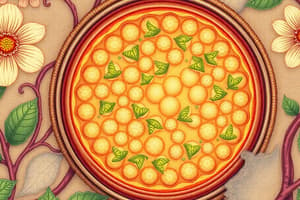Podcast
Questions and Answers
What are organs in plants primarily composed of?
What are organs in plants primarily composed of?
- Structures formed from several tissues (correct)
- Complex interlocking systems
- A single type of tissue
- Groups of similar cells
Which type of meristem is responsible for primary growth in plants?
Which type of meristem is responsible for primary growth in plants?
- Apical Meristem (correct)
- Permanent Meristem
- Lateral Meristem
- Intercalary Meristem
Which type of permanent tissue provides flexible support to the plant?
Which type of permanent tissue provides flexible support to the plant?
- Parenchyma
- Collenchyma (correct)
- Xylem
- Sclerenchyma
What does the vascular system in plants include?
What does the vascular system in plants include?
Which of the following statements best describes permanent tissues?
Which of the following statements best describes permanent tissues?
What role do intercalary meristems play in plant growth?
What role do intercalary meristems play in plant growth?
What is the primary function of xylem in plants?
What is the primary function of xylem in plants?
Which type of simple permanent tissue is involved in storage and photosynthesis?
Which type of simple permanent tissue is involved in storage and photosynthesis?
What is the primary function of collenchyma cells in plants?
What is the primary function of collenchyma cells in plants?
Which component of the vascular tissue system is primarily responsible for transporting water?
Which component of the vascular tissue system is primarily responsible for transporting water?
Which type of root system features a primary root that grows downward with branches growing horizontally or downward?
Which type of root system features a primary root that grows downward with branches growing horizontally or downward?
In which region of the root do the cells undergo rapid elongation and enlargement?
In which region of the root do the cells undergo rapid elongation and enlargement?
Which type of stem is characterized as a slender coiling branch used for climbing?
Which type of stem is characterized as a slender coiling branch used for climbing?
What type of root develops from any part of a plant body other than the radicle?
What type of root develops from any part of a plant body other than the radicle?
Which vascular tissue is responsible for transporting the products of photosynthesis?
Which vascular tissue is responsible for transporting the products of photosynthesis?
Which of the following root systems is typically associated with monocots and consists entirely of adventitious roots?
Which of the following root systems is typically associated with monocots and consists entirely of adventitious roots?
What is the primary function of plant cells?
What is the primary function of plant cells?
Which component of the plant cell is responsible for providing structural strength and protection?
Which component of the plant cell is responsible for providing structural strength and protection?
What role does the nucleus play in a plant cell?
What role does the nucleus play in a plant cell?
Which of the following is NOT a main component of a plant cell?
Which of the following is NOT a main component of a plant cell?
What is the role of the plasma membrane in plant cells?
What is the role of the plasma membrane in plant cells?
Which process do plant cells use to prepare their food?
Which process do plant cells use to prepare their food?
What does the cytoplasm primarily do in a plant cell?
What does the cytoplasm primarily do in a plant cell?
What is one of the key characteristics of the cell wall in plant cells?
What is one of the key characteristics of the cell wall in plant cells?
What is the primary role of the stem in a plant?
What is the primary role of the stem in a plant?
Which of the following is NOT a feature of angiosperms?
Which of the following is NOT a feature of angiosperms?
What initiates the process of seed germination?
What initiates the process of seed germination?
What role do cotyledons play in angiosperm seeds?
What role do cotyledons play in angiosperm seeds?
Which type of plant tissue is classified as simple tissue?
Which type of plant tissue is classified as simple tissue?
Which statement best describes the growth of a seedling?
Which statement best describes the growth of a seedling?
What do fruits develop from in angiosperms?
What do fruits develop from in angiosperms?
Which of the following examples is NOT classified as an angiosperm?
Which of the following examples is NOT classified as an angiosperm?
What differentiates indehiscent fruits from dehiscent fruits?
What differentiates indehiscent fruits from dehiscent fruits?
Which of the following examples is categorized as a samara?
Which of the following examples is categorized as a samara?
Which layer of the pericarp surrounds the seed and is responsible for protection and dispersal?
Which layer of the pericarp surrounds the seed and is responsible for protection and dispersal?
What describes a grain fruit?
What describes a grain fruit?
Which fruit is an example of an achene?
Which fruit is an example of an achene?
What is the primary function of the mesocarp layer in fruits?
What is the primary function of the mesocarp layer in fruits?
Which type of indehiscent fruit is known for having a thick and hard fruit wall?
Which type of indehiscent fruit is known for having a thick and hard fruit wall?
What characteristic defines the exocarp layer of the pericarp?
What characteristic defines the exocarp layer of the pericarp?
Flashcards are hidden until you start studying
Study Notes
Plant Cell Structure
- The basic unit of every living organism, with the ability to grow and reproduce.
- Composed of three main parts: cell wall, cytoplasm, and nucleus.
- Cell wall provides protection and tensile strength, surrounding the plasma membrane.
- Cytoplasm holds the cell's components, protects them, stores molecules for cellular processes, and gives the cell its shape.
- Nucleus controls cell activities like growth and metabolism, carries genes containing hereditary information.
Photosynthesis
- The process by which plants create food using sunlight, carbon dioxide, and water.
- Occurs in the chloroplasts of the plant cell.
Plant Cell Parts
- Plasmalemma/Plasma Membrane plays a crucial role in solute transport into and out of the cell and sensory transduction.
- Mitochondria are membrane-bound organelles where energy production occurs.
- Plastid is a general term for organelles involved in various processes like photosynthesis and storage.
Plant Structures and Tissue Systems
- Stem provides support for the plant, facilitates transport of water, nutrients, and photosynthetic products.
- Root anchors the plant in the soil and absorbs water and minerals.
Angiosperms
- Dominate Earth's vegetation, with approximately 250,000 species.
- Seeds contain an embryo and cotyledons, nourished by the endosperm and protected by a seed coat.
- Examples: Fruit trees like mango, apple, banana, peach, cherry, orange, and pear.
- Grains like rice, corn, and wheat.
Seed Germination and Growth
- Germination occurs under favorable conditions: moisture, temperature, oxygen, and sometimes light.
- Radicle (root) and plumule (shoot) emerge from the embryo during germination.
- Seedling growth is driven by cell division in meristematic tissues.
Plant Development
- Seedling matures through the juvenile stage.
- Produces flowers and fruits following pollination and fertilization.
- Fruits develop from fertilized flowers and contain seeds, completing the plant's life cycle.
Plant Tissues
- Simple tissues contain one type of cell. Examples include parenchyma, collenchyma, and sclerenchyma.
- Complex tissues contain multiple cell types. Examples include xylem and phloem.
- Meristematic tissues are actively dividing cells responsible for plant growth.
- Permanent tissues have lost the ability to divide and are specialized for specific functions.
Types of Permanent Tissues
- Simple Permanent Tissues:
- Parenchyma - living cells with thin cell walls involved in storage, photosynthesis, and wound repair.
- Collenchyma - thicker cell walls, providing flexible support to growing parts of the plant.
- Sclerenchyma - thick lignified cell walls providing rigid support and strength.
- Complex Permanent Tissues:
- Xylem - transports water and minerals from roots to the rest of the plant.
- Phloem - transports photosynthetic products (sugars) from leaves to other parts of the plant.
Plant Organs
- Structures composed of several tissues that perform distinct functions.
- Examples include leaves, stems, and roots.
Plant Systems
- Groups of interacting organs working together as a functional unit.
- Vascular system includes xylem and phloem, responsible for transporting water, nutrients, and food.
Roots
- Root cap protects the tender apex.
- Region of cell division contains small cells with thin walls undergoing repeated cell division.
- Region of elongation undergoes rapid elongation and enlargement, responsible for root length growth.
- Region of maturation produces root hairs.
Types of Roots
- Tap root system has a primary root growing vertically downward with branches extending horizontally or downwards.
- Adventitious root system grows from any part of the plant other than the radicle.
- Fibrous root system is found in monocots, with all adventitious roots.
- Foliar root system grows from leaves, mainly petiole or vein.
Types of Stems
- Bulb - short, erect underground stem.
- Culm - flowering stem of grasses and sedges.
- Offset - a thickened branch growing from the leaf axil, away from the mother plant.
- Rhizome - horizontal underground stem.
- Runner or Stolon - indeterminate aboveground stem with internodes and a new plantlet at the tip.
- Sucker - shoot arising from the old stem below ground.
- Tendril - slender coiling branch for climbing.
Fruits
- Dry Fruits:
- Indehiscent Fruits:
- Achene - one-seeded fruit with the seed attached at one point to the fruit wall.
- Nut - thick, hard fruit wall.
- Samara - fruit wall grows into a wing.
- Grain - one-seeded fruit where the fruit wall and seed coat are fused.
- Schizocarp - several carpels separating into distinct indehiscent fruits.
- Indehiscent Fruits:
- Pericarp:
- The entire fruit wall, composed of the exocarp, mesocarp, and endocarp.
- Exocarp: outermost layer.
- Mesocarp: middle layer, often the edible part.
- Endocarp: innermost layer, often containing the seed(s).
Studying That Suits You
Use AI to generate personalized quizzes and flashcards to suit your learning preferences.





